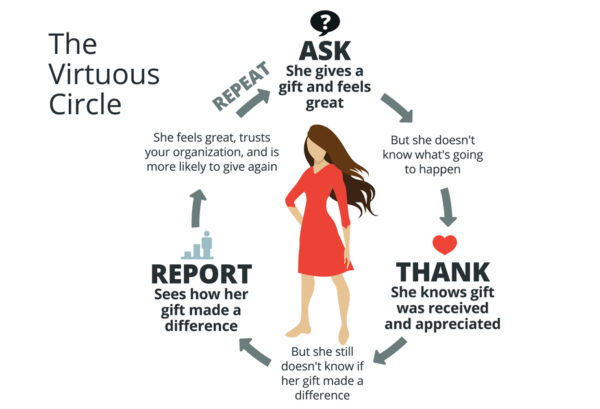Of all the graphics we’ve created, this one gets requested most.
Our “Virtuous Circle” graphic was created to make it easy to see how the simplest building blocks of fundraising work together to create a powerful system.
But we’ve never fully explained it, step-by-step, in writing.
So buckle up. And know that all of this all stems from one of our core principles: doing fundraising in a way that serves donors is your surest way to raising more money.
A “Virtuous Circle” is…
A “virtuous circle” is a chain of positive events that reinforces itself. A positive thing happens, which leads to another positive thing, which reinforces the system and strengthens it over time.
Some fundraising programs are virtuous circles – they’re successful at getting donors to give, then they reward those donors, then those donors give again, etc. These systems raise more money both in the short term and in the long run.
But most fundraising programs aren’t constructed to be rewarding for donors. They’re constructed to be rewarding to the nonprofit itself (organization-centric content that makes internal audiences feel great) and easy to execute (not doing the hard work of designing for donors, writing to their level, doing only one thing with each piece of communication, etc.).
So rather than a system of positive events that reinforce each other, the system loses revenue and leaks more donors than it should.
Let’s look at how you can ensure that your fundraising program is a virtuous circle – and not a vicious circle.
Ask
The Virtuous Circle begins at the top with Ask because most fundraising relationships begin with an ask.
An effective Ask is also the beginning of serving your donors well. A good Ask serves donors by simplifying complex issues and making it easy for donors to make a meaningful difference.
After your donor gives a gift, she feels great. She gets that hit of dopamine that makes her feel warm and connected. She’s just affirmed to herself that she’s the type of person who helps people in need, and that she supports causes that are important.
It’s an incredibly powerful moment.
But it often starts to go sideways immediately because…
A Gift is Different than a Purchase
When your donor makes a gift, she feels great that she gave it. But she doesn’t know whether her gift will have an impact… or not.
This is where it’s vital for nonprofits to know that a charitable gift is different than a purchase of goods or services.
Why? When you make a purchase, you receive a good or service in return. You then judge whether your purchase was a good idea – or not. Was the meal worth it? Was the laptop a good purchase? Was the jacket made well, or did it fall apart after a year?
But when you give a charitable gift, you don’t receive a good or service in return. So you don’t have any evidence that your gift made an impact… or not.
But! Your donor does receive one thing in return: she receives your donor communications.
Therefore, one of the core jobs of your donor communications is to show and tell your donor that her gift to your organization made an impact. Not to convince her that your organization is effective, not to convince her that your organization does lots of good, but to convince her that her gift made a difference.
So she’s given you a gift. What should you do?
Thank
You do what your mom or grandmother taught you: you thank her.
You can read about how to Thank your donors effectively here and here.
But Thanking is only the beginning of the process. Think of it this way: most donors are “buying” two things with their gift: the feeling they get when they give the gift, and that their gift makes a difference.
Even when you’ve Thanked a donor, she still doesn’t know whether her gift made a difference or not. She doesn’t yet know whether her gift to your organization was a good decision.
So you need to…
Report
Reporting is how your donor sees, reads and feels that her gift made a difference.
Very few organizations Report back to donors well. Many organizations don’t realize they should do it. Some organizations want to do it, but instead of Reporting they make organization-centric communications that do more bragging than they do Reporting.
And because many donors never find out whether their gift made a difference… many of them never donate again.
Don’t you feel like your donors deserve to be Reported to? Doesn’t it feel like Reporting is a good way to serve your donors?
And there’s something in it for you, too. If you report powerfully to your donors, you’ll retain more of your donors year over year.
The Benefits
You Asked your donor to make a gift. You Thanked her well so that she feels appreciated. You’ve Reported, so she’s seen and felt that her gift made a difference.
You’ve “closed the circle,” and a host of good things are about to happen to your organization:
- Your donors will trust you more because you Reported to them (when most of the organizations they donate to didn’t Report).
- Because your donors trust you more, they’re more likely to give to your next appeal. So your future appeals raise more money.
- Because your donors give more often, you’re more likely to keep them for longer.
- Because you keep your donors for longer, you raise more money in the long term.
Implementing the Virtuous Circle
Implementation looks like this:
- For Major Donors you have a relationship with, you take each donor linearly through the circle. You Ask them. When they give, you Thank them. You Report back to them. Only after Reporting do you Ask them for another gift. Of course there are occasional exceptions, but the idea is to take each donor through the steps, in order.
- For Mass Donors, you need an ongoing stream of communications throughout the year that is a mix of Asks (appeals, e-appeals) and Reports (newsletters). Of course, Thank every donor who gives a gift. You need multiple Asks and Reports spread throughout the year because a) donors don’t open every piece of mail or email you send them, so you don’t know what they’ve seen, and b) it’s not cost effective to take each donor through the steps in order like it is with Major Donors. Think of it this way: a stream of several appeals and newsletters throughout the year isn’t perfect for anybody, but based on all our testing, we know it’s what’s best for your mass donors as a group.
Repeat
If you’ve taken your donors through the Virtuous Circle, you can Repeat the circle. You’ve earned the right to Ask your donor again.
And you’re going to raise more money.
Because the system most organizations are putting their donors through is either “Ask, Thank, Ask” or “Ask, Thank, Brag.”
But with the Virtuous Circle of Ask, Thank, Report, your organization will have a communications program that treats donors the way they should be treated – and this program raises more money.
This Maya Angelou quote sums it up best:
- “I’ve learned that people will forget what you said, people will forget what you did, but people will never forget how you made them feel.”
Because your donors don’t get every piece of communication you send.
They don’t remember (or even read) most of the words that you say.
But if your donors can feel that your organization is about more than just their donation – that your organization will go the extra mile to make sure they know their gift made a difference – that’s when the magic happens. It’s when your donors start to feel like maybe your organization exists to help them be great, instead of being just another charity that wants their money.
The Virtuous Circle makes donors feel valued and important by centering your communication strategy and program around your donors and their needs. And when you serve your donors’ needs, you tend to raise more money.
Steven Screen is Co-Founder of The Better Fundraising Company and lead author of its blog. With over 30 years' fundraising experience, he gets energized by helping organizations understand how they can raise more money. He’s a second-generation fundraiser, a past winner of the Direct Mail Package of the Year, and data-driven.









4 comments on “Your Fundraising Communications Should Create a Virtuous Circle”